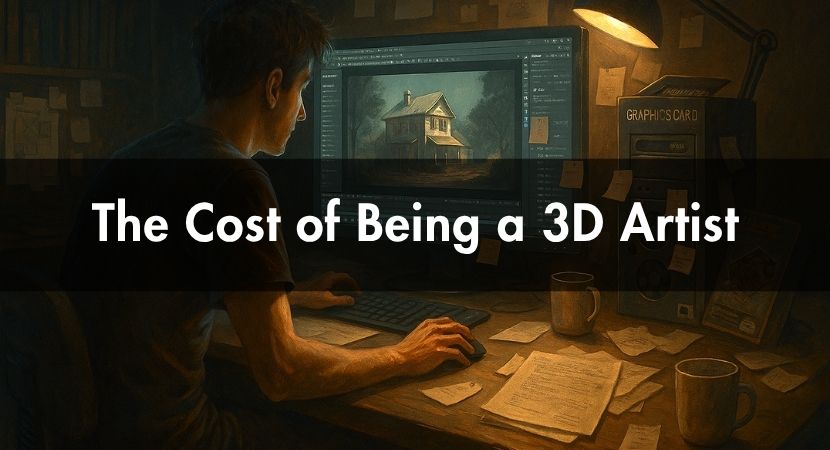
Being a 3D artist might seem like a dream job from the outside, with beautiful images, freedom of creative expression, and the satisfaction of bringing architectural or imaginary worlds to life. In this article, we’ll go deep into some insights and try to paint a real picture of what it costs to become a professional 3D artist today!
We wanted to understand what artists actually spend when starting out, how they deal with licensing, how they learn, and ultimately, what challenges they face in their journey. The answers we received reflect not just numbers, but stories; stories of passion, sacrifice, and slow, steady growth.
What many people don’t see is the cost, both literal and emotional, that lies behind each render. In the VWArtclub Facebook group, we ran a series of polls to explore this topic and the results were honest and I would say eye-opening.
Starting Out - The Budget Reality.
Before diving into software, render engines, or even artistic skills, every 3D artist faces one simple but often stressful question: how much money do I need to begin? It’s a question filled with anxiety, especially when your passion for 3D art is strong but your wallet is not.
Initial Investment Ranges.
Let’s begin with what is perhaps the most fundamental question: how much does it cost to get started in this field? We asked our members to estimate their initial investment and that means the budget they had when they decided to take their first serious steps into the 3D world.
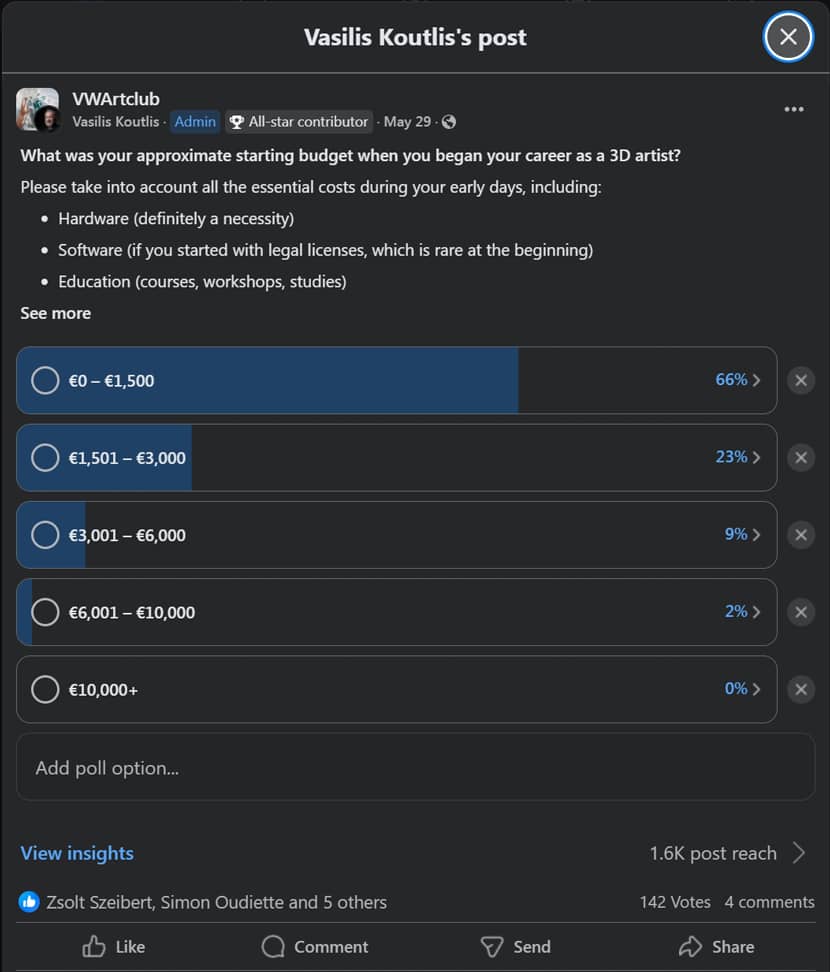
The result? A massive 66% of respondents stated they began with a total budget of under €1,500. This included everything from hardware to software to educational resources. It’s a number that reveals just how many of us started on a shoestring budget, making the most of limited resources.
Another 23% invested between €1,501 and €3,000, a moderate range that likely includes those who either bought a decent machine or paid for a few courses. Only a tiny percentage (2%) said they invested over €6,000. This clearly shows that the majority of 3D artists in our community didn’t begin with large capital or expensive setups and that they started humbly building their way up.
And what did this initial budget typically cover? We encouraged voters to factor in not just hardware, but also software (if they paid for it), online courses or school tuition, and the purchase of basic asset libraries. It’s amazing to think how much some managed to achieve with so little in the beginning!
Hardware – What Did We Really Start With?
Every career begins somewhere, and in 3D, that 'somewhere' is usually a noisy fan, a heating CPU, and the eternal struggle to rotate a scene smoothly. We wanted to know: what was your first setup like?
What Setup Did They Start With?
One of the most important investments for any 3D artist is hardware. Without a capable machine, you're limited not just in rendering, but even in basic viewport navigation. So we asked: What kind of setup did you use when you first got started?
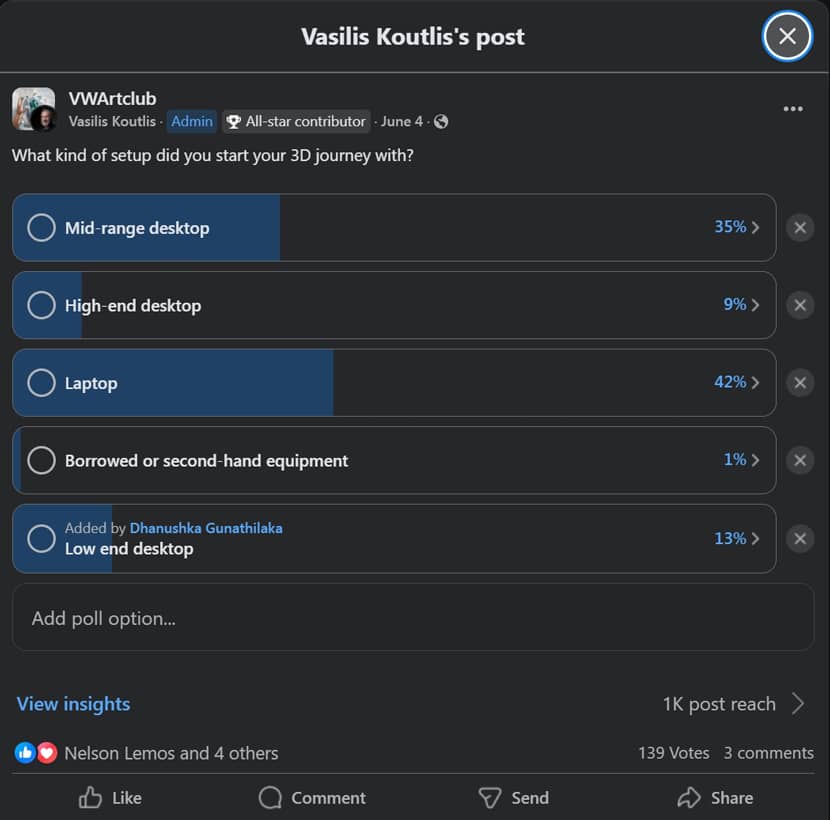
Interestingly, 42% said they started on a laptop. This is perhaps no surprise for many 3d artists - speaking personally, it was a big surprise - as laptops are often the most accessible device for beginners. Another 35% started with a mid-range desktop, while only 9% had a high-end machine. A few (1%) started with borrowed or second-hand equipment. We also had community members add another valid category: low-end desktops, which received 13% of the vote.
The picture here is clear—very few 3d artists had powerful workstations when they began. They simply worked with what they had, often pushing outdated machines to their limits, relying on patience and clever optimization tricks to get things done!
And for those times when your machine just can’t keep up, it’s good to know that render farms like RebusFarm are here to help lighten the load. It’s a great way to boost your rendering power without having to invest in expensive hardware, especially when you’re just getting started.
Upgrade Habits.
When we asked about upgrade frequency, the responses were equally revealing.
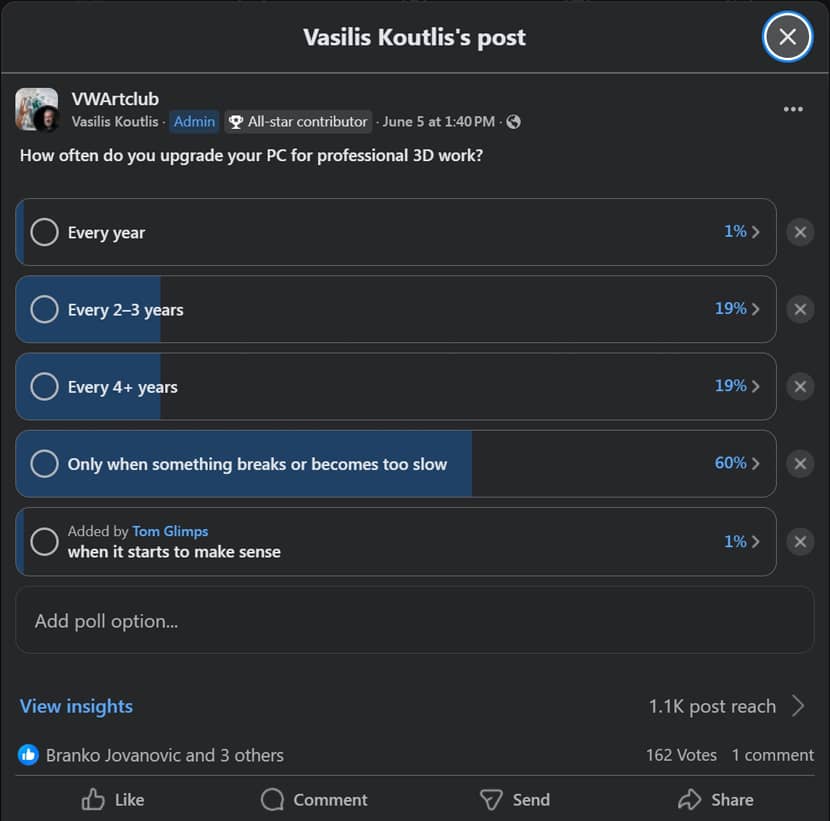
A significant 60% said they only upgrade their PC when it either breaks or becomes too slow to continue working. In contrast, only 1% said they upgrade every year, and 19% each said every 2–3 years or every 4+ years. This again shows that most artists don’t have the luxury of constant upgrades and tend to stretch their tools as far as they can.
Software - Legal, Free, or Pirated?
Now, let’s talk about one of the most debated (and quietly acknowledged) aspects of starting in 3D: software. Licenses can be costly, subscriptions endless, and options overwhelming.
Legal Licensing.
This is a touchy subject, but one that needs to be addressed honestly. We asked our audience a direct question: Did you start your career using legal software? And the answers were as candid as they were expected.
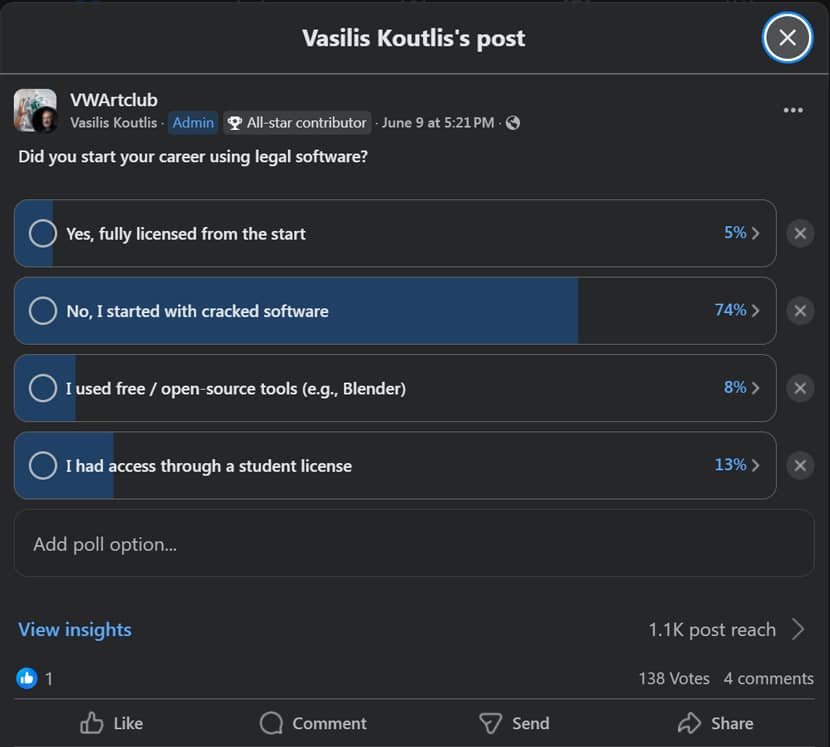
A huge 74% of respondents admitted to starting with cracked software. Only 5% said they began with fully licensed tools, while 8% used free or open-source software like Blender. Another 13% had access through student licenses.
These numbers are not shocking and they’re real. They reflect a harsh truth in the industry: software is a lot and all of them together are quite expensive, and many aspiring artists simply can’t afford the high cost when they’re starting out. That said, it’s also important to highlight that many of these same artists later transition to legal licenses once they’re in a position to pay for them. The poll wasn’t meant to shame but it was meant to show just how common and widespread this challenge is.
Education - Paid Learning or Self-Taught?
While some creatives go through formal institutions, many simply can’t afford that route or they can't find a related field of studies in their country. But does that stop them? Absolutely not. We wanted to explore how our community actually learned the skills needed to become 3D professionals.
Training Paths.
Another key area we explored was education. How do most artists learn their craft? Do they go through academic programs, pay for online classes, or teach themselves?
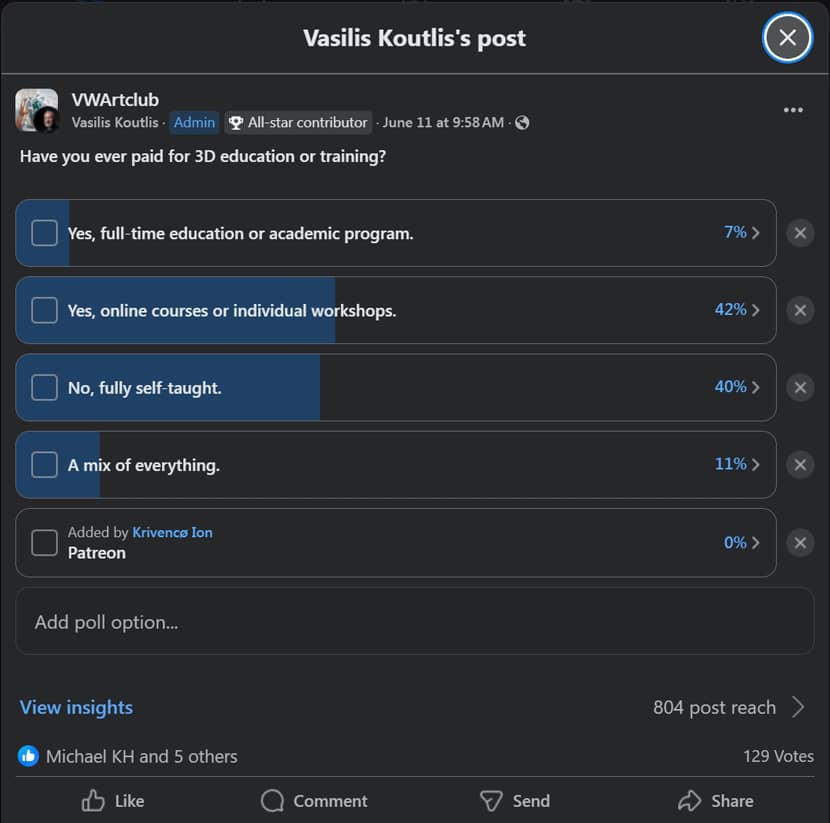
From 129 responses, 42% said they paid for online courses or individual workshops (platforms like Domestika, Udemy, SOA Academy, and many more). Another 40% reported being fully self-taught, learning through YouTube, experimentation, and community resources. Only 7% said they attended a full-time academic program, and 11% followed a mixed path.
These numbers speak volumes. The modern 3D artist is resourceful. They build their skills through whatever means they can access. The rise of online education has truly democratized learning, and it’s encouraging to see how many have leveraged it to break into the field.
Assets - Where Did You Get Your First Libraries?
A beautiful render isn’t just about lighting and modeling, as it also relies heavily on a solid asset library. But in the early days, not everyone could afford premium subscriptions. So we asked: Where did your first models and materials come from?
How Artists Built Their Libraries.
We also asked our community how they began building their first 3D libraries—materials, textures, models, HDRIs.
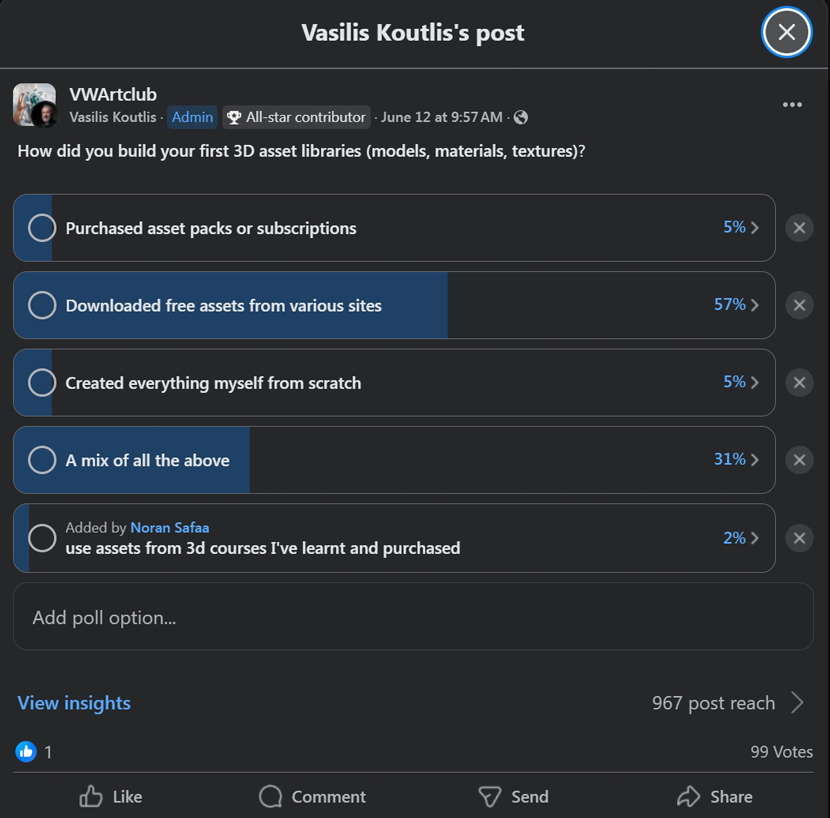
Unsurprisingly, the vast majority (57%) downloaded free assets from various online sources. Another 31% said they used a mix of all available resources. Only 5% said they bought paid asset packs, and 5% created everything from scratch.
These answers highlight again the reality of limited budgets. When you're starting out, free resources are your best friend. Platforms like Sketchfab, CGTrader (free section) and many others have become goldmines for beginners. As artists evolve, many do start purchasing assets or building custom libraries, but at the beginning, it’s all about survival and speed.
Business Setup - When Does it Become Official?
Going from enthusiast to professional doesn’t happen overnight. At some point, you realize you need to issue invoices, pay taxes, and operate like a business. But when does that happen for most 3D artists?
When Did They Go Official?
One of the most interesting polls revolved around professional registration. We asked our members how long after starting 3D work they actually registered as freelancers or businesses.
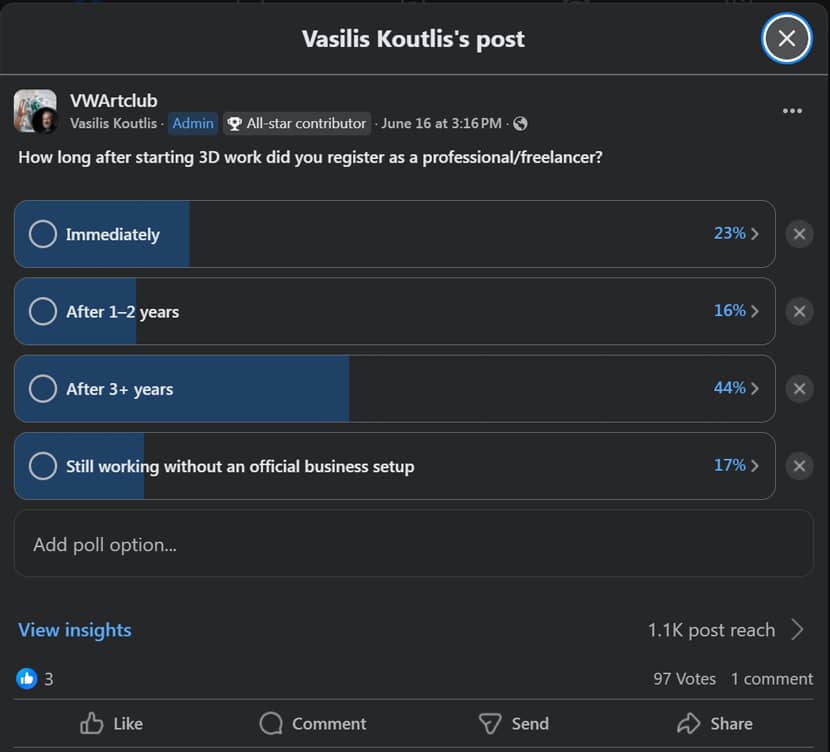
Only 23% said they registered immediately. A larger group, 44%, waited more than 3 years, while 16% registered after 1–2 years. Interestingly, 17% said they are still working without an official business setup.
This tells us that many artists spend years working under the radar, either as part-timers, hobbyists, or informal freelancers. The transition to "professional" status doesn’t happen overnight and it’s obviously a process that often takes time, confidence, and financial stability.
The Invisible Cost - Mental & Emotional Challenges.
Money and tools are one side of the story, but what about the emotional part? Being a 3D artist means constant learning, dealing with feedback, working under pressure, and often sacrificing personal time. So we asked our members: what challenges hurt the most?
What's the Biggest Challenge?
And finally, we touched on a topic that often goes unspoken: the emotional and mental strain of being a 3D artist. From endless client feedback to uncertain income and the never-ending pressure to improve, the job can be both exhausting and isolating.
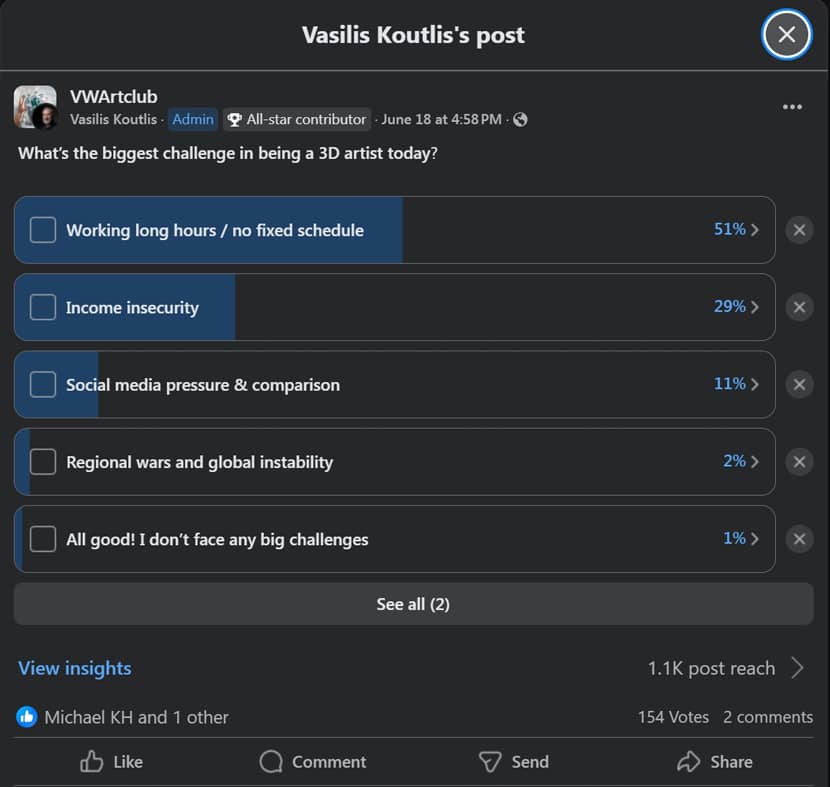
From 154 responses, over half (51%) said their biggest challenge was working long hours with no fixed schedule. This isn’t surprising—render times, revisions, and tight deadlines often eat into personal time. 29% said income insecurity was their main source of stress, while 11% cited social media pressure and comparison with others. A small but significant number (2%) mentioned regional wars and global instability as affecting their careers. And just 1% felt they weren’t facing any major challenges at all.
This is perhaps the most powerful section of our survey. It reminds us that behind the beautiful images lie real people, dealing with real-life pressure. The emotional cost is very real and acknowledging it is the first step toward creating a healthier industry culture.
For those of you who haven't had the chance to read our previous article titled 3Depression, I would highly recommend taking a look. It dives even deeper into this emotional side of 3D art, exploring how artists not only build careers but also need to build inner strength. Knowing how to protect your mindset is just as important as learning your tools.
Experience certainly plays a role, but information is powerful. When you're informed, you become aware and when difficult moments arrive (and they always do), you'll be far more prepared to handle them. Mental resilience doesn't come overnight, but the sooner we talk about it, the sooner we learn how to nurture it.
Final Thoughts - A Career Built on Passion, Not Comfort.
Every render has a cost and not just the electricity for your workstation. It’s the result of countless hours, sleepless nights, self-doubt, tight budgets, and an overwhelming desire to create. But the good news? You're not alone.
What we learned from these polls isn’t shocking at all, but it is incredibly grounding. The path to becoming a 3D artist is filled with challenges, both financial and emotional. Most start with modest tools, pirated software, and free tutorials. They work countless hours, upgrade only when absolutely necessary, and delay going official until they feel ready. Yet, despite all that, they persist. They create. They grow. And eventually, many of them find their footing and begin to thrive.
So if you're just starting out, or even if you’ve been at it for a while, know that you’re not alone. Your struggles are shared by thousands of others in this global community. And perhaps most importantly, they don’t define you. What defines you is your dedication, your hunger to learn, and your love for this beautiful craft.
I hope this article helped shed light on the true cost of being a professional 3D artist. If it resonated with you, share it with your peers, start a discussion, and keep the spirit of honesty alive in our creative world.
Kind regards & Keep rendering! 🧡
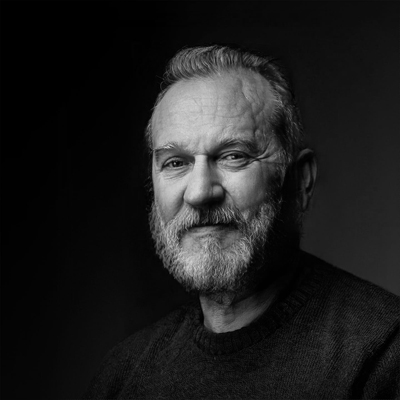
About the author
Vasilis Koutlis, the founder of VWArtclub, was born in Athens in 1979. After studying furniture design and decoration, he started dedicating himself to 3D art in 2002. In 2012, the idea of VWArtclub was born: an active 3D community that has grown over the last 12 years into one of the largest online 3D communities worldwide, with over 160 thousand members. He acquired partners worldwide, and various collaborators trusted him with their ideas as he rewarded them with his consistent state-of-the-art services. Not a moment goes by without him thinking of a beautiful image; thus, he is never concerned with time but only with the design's quality.

